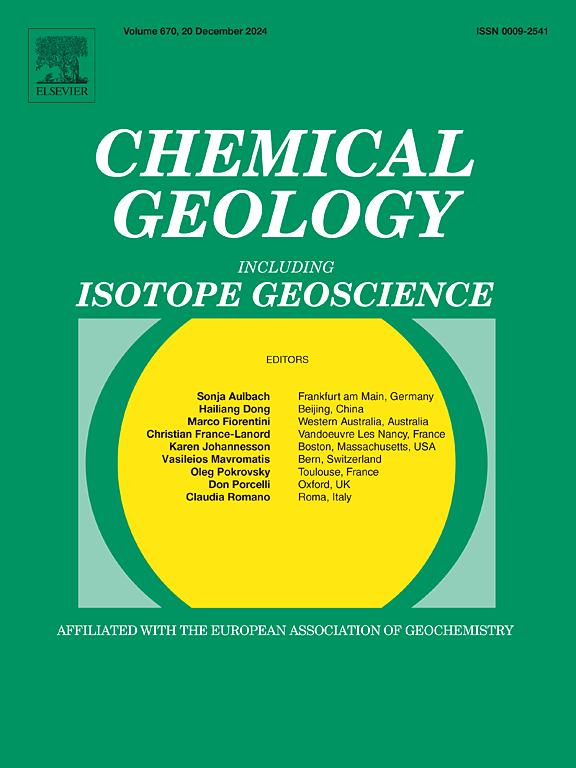Characterisation of deep intra-continental magma reservoirs – Insights from noble gases and p-T estimates into the western Eger Rift (Czech Republic)
IF 3.6
2区 地球科学
Q1 GEOCHEMISTRY & GEOPHYSICS
引用次数: 0
Abstract
The western Eger Rift (Czech Republic) is a currently inactive volcanic rift that is characterised by earthquake swarm activity and degassing of mantle-derived fluids. Free gases and (ultra-) mafic phenocrysts and xenoliths are used to determine the origin and evolution of volatiles in the system and to define the magma reservoir p-T conditions. Isotope compositions of helium in both fluids and minerals are up to 6.79 RA. 20Ne/22Ne ratios range up to ∼11.0 and 21Ne/22Ne ratios up to ∼0.048. Correction for isotopic mass fractionation of Ne suggests a source of mixed atmospheric and mantle type components with a significant crustal input. The slightly lower-than-mantle 3He/4He ratios and the Ne isotopic compositions indicate that these gases may have been impacted by a subduction-related crustal component during the Variscan (or Hercynian) Orogeny. 40Ar/36Ar ratios range up to 4680. Such higher-than-atmospheric values in most mineral and free gas samples indicate that Ar likely derives from the mixing of atmospheric and mantle sources as well. Thermobarometry of ortho- and clinopyroxene rim pairs of matrix grains yields predominantly p-T conditions of 1.1 ± 0.5 GPa and 700 ± 100 °C, respectively, indicating a lithospheric depth of 40–45 km for 1.5 GPa and 20–25 km for 0.5 GPa. Conversely, pairing cores of mm-sized pyroxenes points to p-T conditions of 2.5 ± 0.5 GPa and 1100 ± 100 °C, corresponding to a lithospheric depth of ∼75 km. The diverse chemistry and the wide range of p-T conditions characterising the crystals indicate magma ascent.
求助全文
约1分钟内获得全文
求助全文
来源期刊

Chemical Geology
地学-地球化学与地球物理
CiteScore
7.20
自引率
10.30%
发文量
374
审稿时长
3.6 months
期刊介绍:
Chemical Geology is an international journal that publishes original research papers on isotopic and elemental geochemistry, geochronology and cosmochemistry.
The Journal focuses on chemical processes in igneous, metamorphic, and sedimentary petrology, low- and high-temperature aqueous solutions, biogeochemistry, the environment and cosmochemistry.
Papers that are field, experimentally, or computationally based are appropriate if they are of broad international interest. The Journal generally does not publish papers that are primarily of regional or local interest, or which are primarily focused on remediation and applied geochemistry.
The Journal also welcomes innovative papers dealing with significant analytical advances that are of wide interest in the community and extend significantly beyond the scope of what would be included in the methods section of a standard research paper.
 求助内容:
求助内容: 应助结果提醒方式:
应助结果提醒方式:


